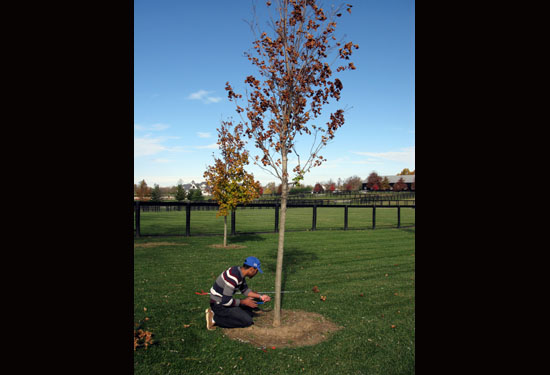UK researcher finds molecular markers for common woody plant disease
UK researcher finds molecular markers for common woody plant disease

A researcher in the University of Kentucky College of Agriculture, Food and Environment has developed a molecular technique for diagnosing Verticillium wilt, a common, but often hard to diagnose, disease affecting 80 tree species and more than 300 plant species. This finding by Baker Aljawasim, a graduate student in the Department of Plant Pathology, will allow plant disease diagnosticians nationwide to identify the disease easier and quicker.
The fungus that causes the disease, Verticillium dahliae, survives for more than 14 years in the soil and enters the plant through the roots. It then moves up through the xylem, the plant’s vascular system that transports water and nutrients from the roots up to the leaves. Inside the plant, the fungus cuts off the flow of water and nutrients, first to the leaves and then to the rest of the plant. Fungicides are not effective at controlling this disease, because they cannot reach the fungus inside of the xylem.
Symptoms of Verticillium wilt include brown or dry leaves, leaf death, discoloration on the twigs and wilting or partial or total tree death. It is commonly found on fruit and nut trees, urban and landscape plants, forest trees and nursery trees.
“These symptoms are not a great indicator of the disease because they are too similar to other diseases, including both infectious and noninfectious problems,” Aljawasim said. “It is also difficult to isolate the fungus in the laboratory because it has to have a specific medium to reproduce. It grows slowly, so it may be overrun by the growth of other organisms.”
He added that other difficulties in disease management include the great number of plants the fungus can attack, and the length of time the fungus can survive in the soil. Also many of the woody plants the disease targets tend to have a long life, and resistant cultivars are not available. The fungus is found across the majority of the United States.
Aljawasim, a graduate student in UK extension plant pathologist Paul Vincelli’s lab, took advantage of unique characteristics of the fungus by extracting DNA from infected twigs using a drill bit and a pencil sharpener and then using a drill press to further break down the wood shavings. Unique characteristics of the fungal DNA were amplified to serve as molecular markers for plant pathologists.
Aljawasim tested his molecular markers in trees that had symptoms of Verticillium wilt as well as in trees that were not yet showing symptoms. In his tests, the markers were able to positively identify the infection in plants with symptoms as well as those that were infected but not yet showing symptoms, showing that the technique is highly sensitive and reliable.
“While this technology is expensive, the technique provides UK with improved diagnostic capabilities for critical cases,” Aljawasim said. “In addition, this new technique may be useful for improving management programs for Verticillium wilt in the future by limiting dispersal of infected transplants, which is the most common way the fungus is spread.”
Crops Extension Forestry Horticulture Research


